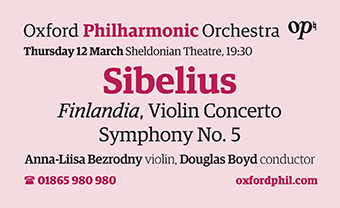Oxford Philharmonic had had a sell-out concert on their hands until the wrecking ball known as COVID-19 discouraged a fair few concertgoers from showing up on the night. In the circumstances, I thought the turnout very satisfactory - and certainly the Sheldonian lacked for nothing in atmosphere.
When Finlandia was composed in 1899, Finland was still a grand duchy of the Russian empire, and the piece was something of a musical/political protest by Sibelius. He was not the first to compose patriotic music to stir one's countrymen's hearts. Haydn did it, and so did Tchaikovsky and Elgar. Audiences are frequently surprised by how the familiar tune comes so late on, well after the strong chords at the start have been succeeded by threatening brass and percussion as the pace quickens. The famous anthem cannot fail to excite, and comprised a rousing start.
There was more music to set the pulse racing when Anna-Liisa Bezrodny took the floor for her solo spot with Sibelius' Violin Concerto, his one and only concerto. It's a testament to the Orchestra's in-depth strength in the strings section that Bezrodny does not usually take her seat in the front row of the first violin sub-section; rather, standing before us, she played with bowed head and eyes closed, sometimes half-crouching; dragging the last ounce of emotion from her fiddle.
Bezrodny was straight into the great outpouring of melody – nothing here of Sibelius' usual practice of gathering seemingly unrelated threads together. The first cadenza is a shortish Bach-like one, but for the second Bezrodny unleashed a torrent of notes, but among the fireworks I had the feeling she had always one ear for the movement's structure. In the Adagio she dealt fluently with the horribly tricky section where the solo part is both theme and accompaniment, and then swept gaily through the gipsy-dance of the finale, blazing out the syncopations and arpeggios later. The performance was a delight, and one based on long experience: I learned in the interval that she had played the concerto perhaps 40 times in public.
The Fifth Symphony followed. Nick Breckenfield's ever-exemplary programme notes described how Sibelius combined the initial two movements into one, and it's always interesting to observe how the effortless flow of the now-Tempo Moderato + Allegro belies the great effort from which it is born. Conductor Douglas Boyd is a noted former oboist and was a founder of the Chamber Orchestra of Europe. Nowadays, he's the director of one of the best-known French chamber ensembles, the Orchestre de Chambre de Paris. There was much fidelity to the marked tempos, particularly in the 'joining' scored section, and then, in the slow movement, Boyd seemed particularly to bring out the connection vis à vis the famous big tune in the finale between the tolling pattern in the double-basses here and its eventual expansion in the finale. I also enjoyed the elongated spaces the conductor allowed between the six sword thrusts at the death – almost teasing his audience into applauding prematurely!




